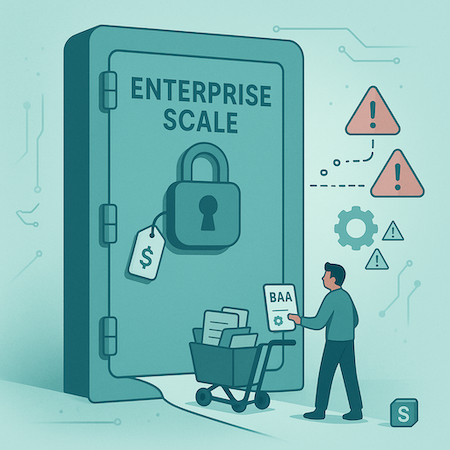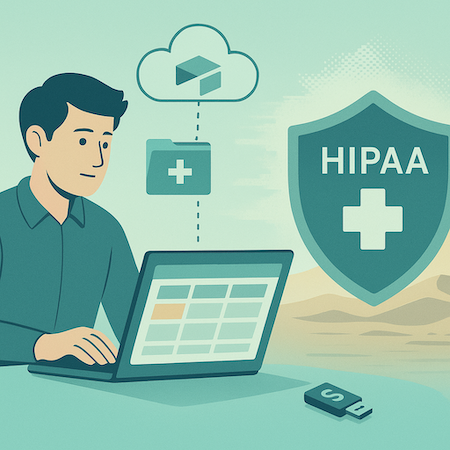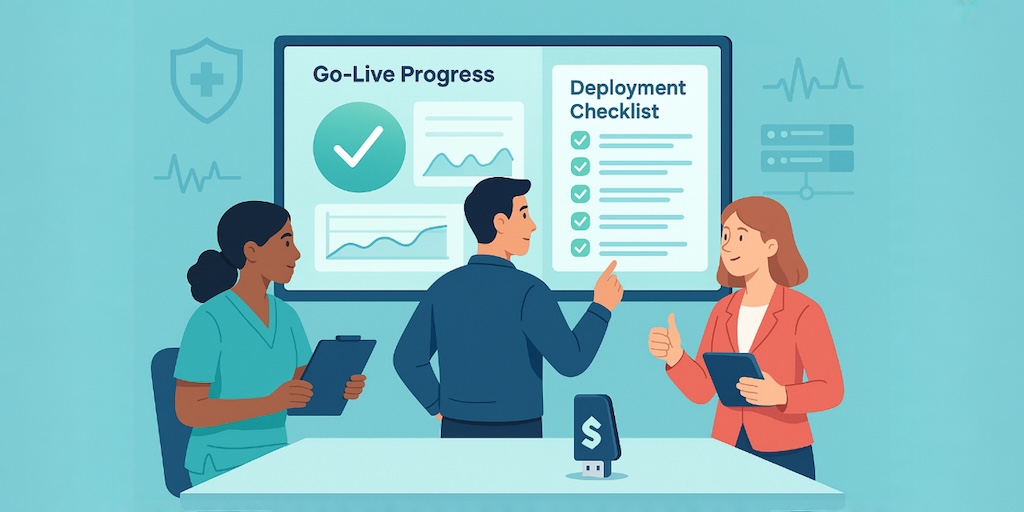Airtable + HIPAA: Compliance or Compliance-Shaped Mirage
Imagine you’ve finally wrangled your clinical MVP into a slick Airtable base—then your lawyer strolls in with a single question: “Where’s your audit log for that Slack zap that just emailed 300 lab results?”
Welcome to the moment every founder realises HIPAA compliance isn’t a toggle in a settings menu—it’s a minefield disguised as a spreadsheet.
Key Takeaways
- Enterprise-only entry fee. Airtable will touch PHI only on the Enterprise Scale plan and after you execute its Business Associate Agreement; every lower tier is strictly off-limits.
- Compliance can implode in one click. Integrations, AI fields, “Send Record” emails, and other shiny features all sit outside the BAA—trigger any of them and you’ve broken the compliance chain.
- Great for giants, brutal for startups. The costs and ongoing governance Airtable demands make sense for hospital systems with compliance teams; everyone else should start on a HIPAA-first framework like Specode rather than duct-taping controls onto a grid.
Airtable’s Siren Song: Why Health-Tech Builders Still Reach for the Spreadsheet-on-Steroids
It’s everywhere. When Airtable boasts that 80% of the Fortune 100—plus biotech heavyweights like Benchling and even mental-health outfits such as Connections Wellness Group—run their workflows on its deceptively friendly grid, a cash-strapped founder inevitably figures, “If it’s good enough for them, it can babysit my PHI demo data for a few sprints.”

Mass-market credibility
Airtable now powers north of 450k organizations worldwide—that social-proof banner feels a lot like a shield against “Are you using real software?” investor side-eye.
On-ramp smoother than a California freeway at 2 a.m.
The UI is still a familiar grid, but each column can morph into a file attachment, a barcode, or today’s favorite buzzword: an AI-generated summary of yesterday’s stand-ups. Drag-and-drop beats wrangling a Postgres schema when your clinical co-founder wants a demo yesterday.
Built-in automations & shiny AI toys
Native triggers (“If new record → ping Slack”) and the headline features—AI App Building and AI Agents—promise you can ship a working pseudo-EHR before lunch.
Template candy
Search “patient intake,” “appointment scheduler,” or even “clinical trial tracker” in the template gallery and you’ll find starter bases that look 90% done. (Spoiler: they’re 60% done at best—but in prototype-land, illusion is nine-tenths of velocity.)
Free-to-cheap early-stage economics
The generous free tier plus $20/mo Pro seats whisper, “Forget that $250/hr AWS DevOps consultant—just paste your CSV.”
Ecosystem glue
One-click connectors to Slack, Google Workspace, Salesforce, and 1,000-plus Zapier/Make recipes mean your MVP can masquerade as a micro-services architecture without a single docker-compose.
Net result: Airtable makes a lean health-tech team feel like it has a full ops crew, product analyst, and junior developer rolled into one. It’s the perfect temporary scaffolding—right up until you realize HIPAA hates spreadsheets in trench-coats. (We’ll dissect that heartbreak in the next section.)
HIPAA Crash-Course (You Can Read This Before Your Latte Cools)
PHI ≠ just “medical records.” If a data point identifies who + what happened (diagnosis, treatment, billing, etc.), it’s protected—even a phone number next to “fever” counts.

Who the law actually chases
“Covered entities” (providers, health plans, clearinghouses) and any vendor that even sniffs that data. The moment you host, sync, or AI-summarize a chart, you’re a “business associate” and must sign a BAA that spells out safeguards and liability.
Three rule pillars, one headache
- Privacy Rule – governs who may look.
Security Rule – demands documented administrative, physical, and technical controls (think encryption, access logs, disaster-recovery playbooks).
Breach Notification Rule – if >500 records escape, you have 60 days to tell HHS and every affected patient (enjoy the press release).
Penalty math that ruins cap tables: Four violation tiers, max $50k per incident, $1.5M per rule per year—plus possible jail time for willful neglect.
Reality check for builders
- Audit logs must be immutable.
- Users need least-privilege, time-boxed access—not a shared “admin@company” login.
- Encrypt in transit and at rest; “private spreadsheet” is not a compliance strategy.
Takeaway: HIPAA isn’t a paper you file—it’s a living controls matrix you must prove works on demand. If your tool can’t tick every box above out of the gate, you’re one breach report away from a very public lesson.
Is Airtable Technically HIPAA-Compliant?
Short answer: only if you buy the Enterprise Scale plan, sign Airtable’s BAA, and run your own in-house compliance boot camp.

Enterprise Scale Plan + BAA: the only door in
- Enterprise-only paywall. HIPAA support didn’t exist until April 2024 and is still gated behind a custom-priced tier that reportedly starts at 20 seats—great for hospital systems, brutal for a three-person digital-health startup.
- Three non-negotiables.
- Enterprise Scale subscription
- Executed BAA (delivered as a “Health Information Exhibit”)
- Customer-side hard work—configure security features, police users, lock down integrations.
- Compliance tooling bundled into the tier. Enterprise brings the goodies—EKM (own your encryption keys), DLP APIs, granular audit logs, SAML SSO, and organization-wide RBAC.
Fine-Print Gotchas (where most MVPs face-plant)
- Shared-tenant audit logs = limited visibility. You can download logs, but they focus on admin events; row-level access attempts and interface clicks aren’t always captured. (Airtable admits logs are still evolving.)
- BYO-Compliance for integrations. The moment PHI leaves Airtable via Zapier, Slack, Salesforce, etc., the BAA stops covering you—you must vet every tool and sign a second BAA or risk a “broken-compliance chain.”
- Feature landmines.
- AI features must stay OFF—they’re explicitly out of scope.
- “Send Record” email button is verboten for PHI; TLS isn’t guaranteed end-to-end.
- Metadata traps. PHI in base names, view titles, or automation text = instant violation.
You can’t just swipe a corporate card and call it a day. Airtable itself reminds customers that an Enterprise license only buys you the toolkit—you must build and prove the controls.
Gap Analysis – Airtable vs. HIPAA Security Checklist
(Yes, a table about a spreadsheet-on-steroids. The irony isn’t lost on us.)
Bottom line: Airtable can be made HIPAA-friendly—if you have Enterprise cash, compliance muscle, and a tolerance for daily risk reviews. If that sounds exhausting, skip the duct tape and start with a framework that’s HIPAA-ready out of the box (hi, Specode).
Developer Workarounds (a.k.a. Juggling Flaming Chainsaws)
Read this only if you’re paid to engineer risk—or enjoy spicy adrenaline in your morning stand-up.

Off-load the PHI, Keep Only “Breadcrumbs” in Airtable
- Shape-shift PHI into opaque IDs. Store patient details in a hardened backend (Postgres on AWS RDS, FHIR store, etc.). In Airtable you keep just a token/UUID that points back to the real record. That satisfies Airtable’s rule that actual PHI lives only inside “Record” cells, not in metadata, emails, or comments.
- Mind the chain of custody. The second that token hops to Slack, Zapier, or a rogue Google Sheet without its own BAA, the compliance chain snaps—and so does your CFO’s pulse.
- Secure bridges exist, but they’re not free. HIPAA-focused middleware like Blaze or Keragon can relay data between Airtable and EHRs while staying under a BAA umbrella—but they add another subscription and another system to babysit.
Reality check: You’ve basically built a two-tier architecture; Airtable is now just a fancy lookup table. If that’s your end-state, ask whether Specode (or even a vanilla FHIR DB + Retool) would be simpler.
Tokenization & Redaction Tricks
- Reversible tokenization: Hash names, MRNs, and DOBs with a keyed HMAC before they hit Airtable; keep the key in a KMS you control.
- Partial redaction: Trim dates to month/year or store age buckets when exact DOB isn’t essential.
- UI re-hydration: Your app or middleware re-assembles the full patient profile only server-side.
- Caveats: Attachments, rich-text fields, and “friendly” column names are danger zones—PHI sometimes sneaks in through copy-paste or auto-generated PDFs. Airtable forbids PHI in those metadata surfaces for a reason.
One Misplaced Zap Can Ruin Your Month
- Native “Send Record” emails are banned for PHI because the receiving server might drop TLS—instant breach.
- Automations/Webhooks inherit your worst integration. A trigger that posts to a non-compliant Trello board or standard Slack channel voids Airtable’s BAA coverage and creates a “broken compliance chain.”
- Fail-closed, not fail-open. Disable all integrations by default, then whitelist only those with signed BAAs and scoped OAuth tokens. Add a DLP rule to nuke any outgoing payload that matches a PHI regex.
- Audit or bust. Even with Enterprise logs, row-level reads via integrations can slip past if you’re not tailing them daily.
Takeaway: Yes, you can jury-rig Airtable into a HIPAA-adjacent tool by treating it like a glorified cache and policing every integration. But if you need that many guards, gates, and guns, maybe start with a platform that’s HIPAA-first—hello, Specode—so you’re building features, not fire escapes.
Decision Matrix: When Airtable Is Fine vs. When It’s a Legal Booby-Trap
Rule of Thumb: If your workflow touches PHI and you don’t have the cash or appetite for an Enterprise license, 24/7 audit reviews, and a third-party-integration police force, Airtable is a spreadsheet-shaped tripwire—not a solution. Time to look at a HIPAA-first platform (cough Specode) instead of duct-taping compliance onto a grid.
HIPAA-First Alternatives If You’re Ready to Ditch the Spreadsheet-on-Steroids
Compliance isn’t a feature toggle; it’s a budget line item that only gets bigger the longer you ignore it. Below are three escape hatches, organized by how much freedom, time, and ibuprofen you’re willing to expend.

Roll Your Own on AWS / GCP + BAAs
Want maximum control? Grab your favorite cloud console and start spinning up VPCs, Postgres clusters, KMS keys, and CloudTrail logs. You’ll get exactly the architecture you want—plus a second full-time job maintaining it.
Pros
- Unlimited flexibility. If you can script it, you can ship it.
- Future-proof for SOC 2, HITRUST, FedRAMP, or whatever alphabet soup tomorrow brings.
Cons
- You inherit the entire shared-responsibility stack—patching, intrusion detection, incident response, the works.
- Requires a security team and a compliance officer; weekend DevOps won’t cut it.
- Expect mid-five-figure annual costs before a single clinician logs in.
Bottom line: This route makes sense only if you’re already budgeting for a CISO and Tier-1 on-call rotation. Otherwise, you’re buying a Ferrari to commute five blocks.
Vertical Health No-Code Tools (with Caveats)
Platforms like Healthie, Keragon, or Blaze promise drag-and-drop workflows with a BAA baked in. They’re miles ahead of Airtable in compliance posture, but you trade openness for convenience.
Pros
- HIPAA clauses are included—sign, pay, and you’re off to the races.
- Non-technical staff can build care plans and dashboards without touching code.
Cons
- Vendor lock-in is real; your data and logic live inside their GUI.
- Extensibility plateau: need bulk-FHIR export or a quirky billing rule? Wait for their roadmap.
- Tiered pricing climbs fast—whitelabel versions can push into five-figures per year.
Bottom line: Ideal for point-solution clinics or proof-of-concept pilots. The minute you need custom workflows or deep EHR integrations, migration gets messy—and expensive.
Specode Shortcut — HIPAA-Ready Components on Day 1
With Specode, you start on third base: encrypted data stores, audit trails, e-prescription modules, and major EHR connectors are already wired up.
Why teams choose this lane
- Compliance by default. Every table, API, and log layer ships hardened for HIPAA.
- 10× speed boost. Reusable UI blocks and AI scaffolding let you move from idea to functional prototype in weeks, not quarters.
- Own your code. Export or extend the stack whenever you’re ready—no black-box risk.
- Cost sanity. One predictable license instead of cloud-sprawl plus compliance consultants.
Bottom line: If you’re a startup or clinician-founder who needs traction and audit readiness, Specode splits the difference between no-code convenience and roll-your-own power—minus the flaming chainsaws.
Next Steps — Build with the Healthcare AI Builder
Prototype anywhere you like; assemble on Specode. Spin up the AI builder for healthcare, describe what you want in plain English, and watch real screens and flows appear on HIPAA-ready rails. Start free to explore; move to Pro when you’re ready to publish; bring in our team on Custom only when you want managed help or purpose-built AI agents.

What happens next (typical 1–2 week path):
- Day 1: Prompt → instant preview for intake, scheduling, messaging, billing. Connect your own data early so the UI reflects real patients, providers, and payers—not mockups.
- Days 2–5: Toggle the integration switchboard (EHR connectivity, eligibility checks, payments, telehealth UX, plus other third-party platforms). Fully brand your workspace.
- Days 6–10: Role-scoped testing with Change Log restore; tune copy, branching, validations, and note templates; ship. No AI magic—sequence and ruthless focus.
Keep the advantages that matter:
- Full code ownership and an escape hatch—no lock-in.
- Start faster on a healthcare foundation: preloaded roles, consent, audit.
- Don’t rebuild what exists: modify packaged components; add only what’s net-new.
- Your team or ours: combine AI-built assembly with custom code whenever you hit unique logic; our Custom tier is there for hands-on help and optional AI agents.
Ready to trade duct tape for deployment keys?
Move fast—just not the “accidentally-email-PHI” kind of fast. Specode gives you speed and compliance in the same sprint.
Q: Will flipping on Airtable’s new AI features break compliance?
A: Instantly. The HIPAA exhibit bans AI fields and agents because they route data through non-covered inference pipelines. Leave the toggle off—or watch your lawyers light up Slack.
Frequently asked questions
No. Backups, revision history, and attachment caches persist for years, so “delete” is really “hide from view.” HIPAA auditors will still call it a breach if those snapshots leak.
Only if you already have a compliance team and a long-term Airtable roadmap. Otherwise you’re buying a gold-plated wrench to tighten one bolt—cheaper to switch to a platform that’s HIPAA-ready out of the box.
Still PHI. Any identifier linked to health data—even a first initial plus appointment date—falls under HIPAA’s 18-item “safe harbor” test. You’ll fail it.
Nice try. Synced or not, if the data crosses Airtable’s servers, it’s in scope. Same BAA, same liability, same breach-notification clock.
Instantly. The HIPAA exhibit bans AI fields and agents because they route data through non-covered inference pipelines. Leave the toggle off—or watch your lawyers light up Slack.









